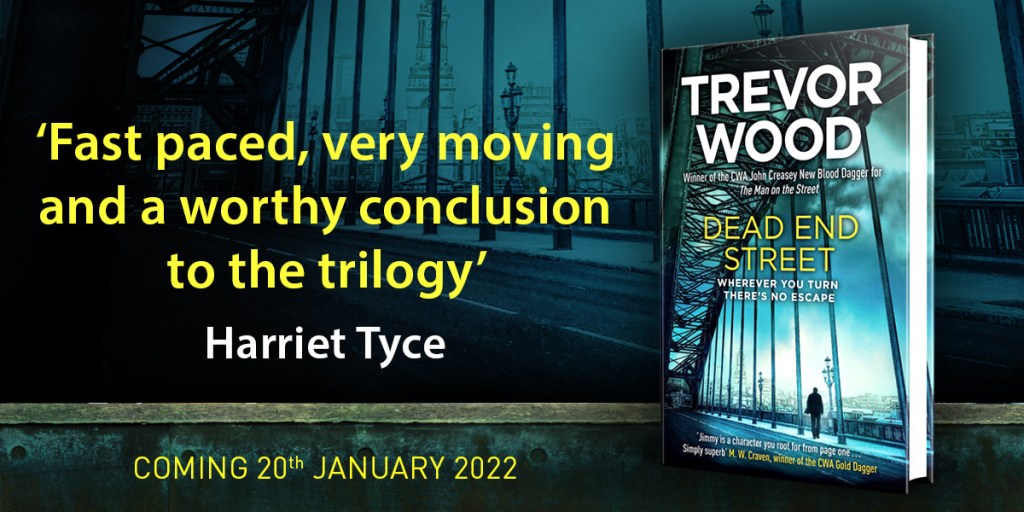Trevor Wood shares his thoughts on writing an award-winning trilogy

With the publication of Dead End Street, Trevor Wood concludes his award-winning trilogy which began in 2020 with The Man on the Street. Here he writes about his experience of writing such a gripping thriller series.
I never intended to write a series.
When I was writing The Man on the Street I had no doubt that it was a standalone. A homeless man who thinks he sees a murder and is compelled to discover the truth is not your standard recurring protagonist, particularly when he lives in the real world, in Newcastle, and not in some fictional murder paradise like Midsomer where people are apparently dropping like flies.
And yet, three years on here I am, celebrating the publication of Dead End Street the final book in what eventually became an award-winning trilogy. Who knew? The obvious answer to that is my editor who, despite my misgivings, insisted from the start that it was a series: ‘People will love the characters,’ she said. And it appears she was right. And it was the characters that convinced me to change my mind.
The Man on the Street tells the story of Jimmy Mullen, a homeless veteran suffering from untreated PTSD. In the book readers not only follow him on his quest to find out what he really saw one dark night on Newcastle’s Quayside, they also learn, through a series of short flashbacks, how he ended up living on the streets. The homeless are routinely demonised and I wanted to humanise them, to make people think a lot more about the person inside the sleeping bag and how they might have ended up crashed out in a doorway. Jimmy’s tragic experiences were just one example of the myriad ways this could happen and it was this that gave me pause for thought.
In the first book Jimmy has two friends, sidekicks if you like, an ageing alcoholic nicknamed Gadge and a young drug addict called Deano and I wanted to know more about their stories – maybe readers would too. And so a compromise was reached – it would be a trilogy and though Jimmy would remain the main character in all three books the other two would get their moment in the spotlight. Deano’s backstory would be filtered into book two, One Way Street. And in the finale, Dead End Street, we would finally learn how Gadge ended up on the streets.
Now I’m not sure how it works in other writers’ worlds but I’m guessing that if they’re writing a series they start with some kind of plan and maybe an idea of each character’s arc – how they got where they are and where they might end up. When you know that you can plant seeds in the early books, leave behind little clues to where the journey is going, give them skills that will come in handy, all that sort of stuff. I had none of it.
Luckily I had a last chance to do some editing. Gadge, who had actually been killed off in the first draft of TMOTS, was miraculously brought back to life, Jimmy couldn’t manage without him. He also suddenly knew his way around computers and had a history of broken marriages – though with Gadge it’s never completely clear whether he’s telling the truth about his past, the man’s a story-teller to his boots. Deano, in contrast, was estranged from his family, could open a simple lock and hotwire a car in a heartbeat. Brushstrokes to start with that could, in time, and over the course of three books hopefully be developed into a bigger picture.
And it wasn’t just the main characters; all series need supporting characters and I had a lot to choose from to take forward into books two and three. Would Aoife, the helpful but bossy librarian survive the cut? And what about Sandy, Jimmy’s sweary and possibly psychic probation officer? Maybe there would be a second resurrection? Kev, the dodgy cop that Jimmy has a violent confrontation with in book one, could return – even though he too was killed in an earlier version. Obviously you’ll have to read One Way Street to find out which ones, if any, made the cut.
And what about Jimmy himself? When we first meet him he’s hiding from life, staying in the shadows, terrified of repeating the mistakes he’s made in the past. Gradually, over the course of the first book, he’s dragged into the light by Carrie, a young woman who needs his help, and by the end he discovers that he’s not the lost soul that he imagined, that he can still make a contribution. Could he continue to grow as the series continues? Maybe he could re-integrate himself into society, find somewhere to live, even get a girlfriend perhaps? His first marriage ended badly but everyone deserves a second chance, surely? All that would be fine except the life expectancy for the homeless in the UK is 45 and Jimmy is already a few years older than that when we meet him. Is it too late for him?
I guess you’re going to have to read the books to find out.





